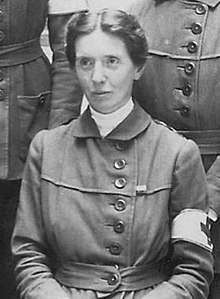Flora Murray
| Flora Murray CBE | |
|---|---|
 Flora Murray in 1914 | |
| Born |
8 May 1869 Dumfries, Scotland |
| Died |
28 July 1923 (aged 54) Hampstead, London, England |
| Cause of death | complications from surgery for bowel cancer |
| Nationality | Scottish |
| Education |
London School of Medicine for Women Durham University |
| Occupation | physician |
| Known for | suffragette |
Flora Murray CBE (8 May 1869 – 28 July 1923)[1] was a Scottish medical pioneer, and a member of the Women's Social and Political Union suffragettes.[2]
Early life and education
Murray was born on 8 May 1869 at Murraythwaite, Dumfries, Scotland, the daughter of Grace Harriet (née Graham) and John Murray, a landowner and Royal Navy captain.[3] She attended school in Germany and London before going on to study to be a doctor at the London School of Medicine for Women. She completed her medical education at Durham University, receiving her MB BSc in 1903, and MD in 1905. She received a Diploma in Public Health from the University of Cambridge in 1906.[4] She worked initially in Scotland before returning to London.
Medical career
In 1905 Murray was a medical officer at the Belgrave Hospital for Children and then an anaesthetist at the Chelsea Hospital for Women. In 1905 The Lancet published an article that she authored on the use of anaesthetic in children, titled Ethyl chloride as an anaesthetic for children.[5]
Suffragette
She joined the Women's Social and Political Union in 1908, and acted as physician to the militants. She spoke at meetings and rallies, marched in processions, provided first aid at suffragette demonstrations, and looked after Emmeline Pankhurst and other hunger-strikers after their release from prison. She campaigned with other doctors against the forcible feeding of prisoners.[6]
Women's Hospital for Children
.jpg)
In 1912 she founded the Women's Hospital for Children at 688 Harrow Road with Louisa Garrett Anderson. It provided both health care for working-class children of the area, and gave women doctors their only opportunity to gain clinical experience in paediatrics in London; the hospital's motto was Deeds not Words.[6]
WW1
In the First World War she served in France with the Women's Hospital Corps (WHC). Along with her partner and colleague Dr Louisa Garrett Anderson, she established military hospitals for the French Army in Paris and Wimereux. Their proposals were at first rejected by the British authorities, but eventually the WHC became established at the military hospital, Endell Street Military Hospital, Holborn, London staffed entirely by women, from chief surgeon to orderlies. Their motto Deeds not Words was used for the second time.
Death
She is buried at the Holy Trinity Church beside her partner and colleague, Dr Louisa Garrett Anderson near to their home in Penn, Buckinghamshire. Garrett's tombstone reads "We have been gloriously happy".
See also
References
- ↑ Flora Murray. findagrave.com
- ↑ Murray, Flora (1869–1923), physician and suffragette | Oxford Dictionary of National Biography. doi:10.1093/ref:odnb/56304.
- ↑ "SR Birth Search Return for birth of Flora Murray 1869". Scotland's People.
- ↑ Group, British Medical Journal Publishing (1923-08-04). "Flora Murray, C.b.e., M.d., D.p.h". Br Med J. 2 (3266): 212–212. doi:10.1136/bmj.2.3266.212-a. ISSN 0007-1447.
- ↑ Murray, Flora. "ETHYL CHLORIDE AS AN ANÆSTHETIC FOR INFANTS". The Lancet. 166 (4291): 1542–1543. doi:10.1016/s0140-6736(01)69925-2.
- 1 2 Geddes, J. F. (2007). "Deeds and words in the suffrage military hospital in Endell Street". Medical History. 51 (1): 79–98. doi:10.1017/s0025727300000909. PMC 1712367. PMID 17200698.
.jpg)